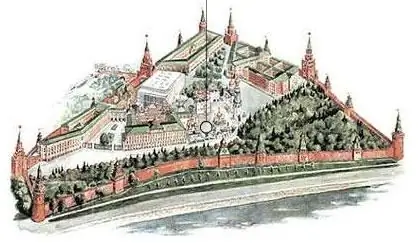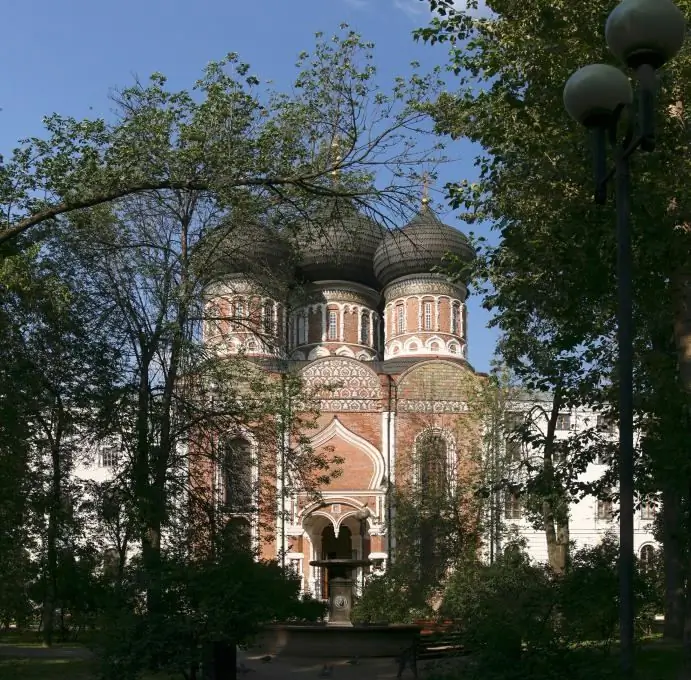- Author Harold Hamphrey [email protected].
- Public 2023-12-17 10:06.
- Last modified 2025-01-24 11:10.
Every resident of the northern capital will tell you where the majestic snow-white Izmailovsky Cathedral is located. The address of this largest Orthodox church in our country: St. Petersburg, Izmailovsky Prospekt, the seventh building. Defiled after the revolution, but today completely restored, the cathedral can rightfully be considered a symbol of the Russian state of Russia.

History of Creation
On a sunny warm May day in 1828, the ringing of bells in the presence of Empress Maria announced that a cathedral had been laid in St. Petersburg. The Life-Giving Trinity, the Life Guards of the Izmailovsky Regiment, which did not know defeat, the temple had a special purpose. The imperial military formation did not have its own church, and therefore the soldiers and officers had to visit other parishes. The decision to build a stone temple was made by Emperor Nicholas I. It was at his request that the Trinity-Izmailovsky Cathedral was to have three aisles and accommodate up to three thousand people.
Constructionthree people were in charge: the emperor, the author of the project, the architect Vasily Stasov, and the engineer Pyotr Bazin, who led the Committee for Buildings of St. Petersburg. Nicholas I controlled the construction process, he personally approved the projects.
The construction of the cathedral was difficult enough. During the construction of the foundation, twice as many piles were driven in as originally planned. The base was made of limestone slabs, the lower part of the outer walls was made of granite, and the columns were made of brick.

Architectural Ideas
The Trinity-Izmailovsky Cathedral was built for seven long years. When developing the project, the architect Stasov took as the basis the idea of the triumph of Russia and its army. The majestic cathedral, with its incredible size, was second only to St. Isaac's Church, which was being built around the same time. According to the plan, the building was an equilateral cross with an unconventional arrangement of heads for Russian architecture: they were located along the axes of the cross. The central massive drum crowning the building dominated the entire building. The cathedral had three chapels, of which the main one was dedicated to the Holy Trinity, the southern - to St. Mary Magdalene, north - St. John the Warrior.
Opening
On May 25, 1835, the church was consecrated. Early in the morning, the bell ringing marked the blessing of water, and then Archimandrite Nil consecrated the chapels. The Imperial family visited the Izmailovsky Cathedral in St. Petersburg the same day in the evening, after returning from Moscow. The emperor, having inspected the temple in detail, expressed his favor to the architect. Trinity buildingcontemporaries evaluated the cathedral as one of the major achievements of domestic architecture. Today, believers come to see it not only from the farthest corners of our country, but also Orthodox from all over the world.

Description
Today the Cathedral on Izmailovsky Prospekt is a huge five-domed building with four white Corinthian porticos. It, as it was planned, accommodates more than three thousand people. The blue dome of the cathedral is visible twenty kilometers from the city. It is considered the second largest in Europe. The wooden dome was created in 1834 by engineers P. Melnikov and P. Bazin.
In 1836 marble commemorative plaques were built into the walls of the cathedral. They are engraved with the names of the officers of the imperial regiment who fell in the battles of Austerlitz, Friedland, Kulm and Borodino.
Izmailovsky Cathedral was built in the Empire style. Its height is about eighty meters. Blue domes are painted with gold stars. The facades are decorated with four six-columned porticos and sculptural friezes. In the niches there are bronze figurines of angels. They were created by the sculptor S. Galberg. The famous Leppe also worked on the frieze.
Interior
Izmailovsky Cathedral is spacious and bright. The feeling of space is created thanks to the features of the interior. Twenty-four slender Corinthian columns "raise to the top" the drum of the main dome, trimmed with caissons with rosettes. It seems that he is floating in the air.

Andcolumns and pilasters are made of white marble. Initially, it was proposed to cover them with white adhesive paint on ordinary plaster, but the regiment's leadership petitioned for permission to veneer them.
Small domes, painted with golden stars on a blue background, are designed to create additional under-dome interiors. One of them has a carved iconostasis. At first it was a rounded wall. Today this iconostasis, unfortunately, is partially destroyed. The altar canopy is designed as a semi-rotunda of four columns. She, with a carved wooden iconostasis, makes up the overall composition.
To the consecration of the temple, Nicholas I presented jasper vessels, made in a gold frame, and a tabernacle in the form of a temple with columns, carved from pink agate. The bronze three-tier chandelier, made in 1865, was disposed of in the forties of the last century, when the Trinity-Izmailovsky Cathedral was closed.
Shrines
In the cathedral there is an ancient icon of the Holy Life-Giving Trinity. It is considered the oldest among all available in St. Petersburg churches. The image was created more than six centuries ago - in 1406. He has an amazing fate: after the revolution, the Soviet authorities seized it. The icon was sent to the Tretyakov Gallery, and then sold to a private collection in the United States. At the beginning of the millennium, the image was bought from an auction by Christie's. During the 300th anniversary of St. Petersburg, the icon was donated to the cathedral by President Putin.

Thousands of believers annuallycome to St. Petersburg and visit the Izmailovsky Cathedral to bow to the old woman Matrona of Moscow. After all, it is here that a particle of the relics of the blessed old woman constantly resides. People tell her about their troubles and, as testimonials testify, through fervent prayers they immediately receive answers to all their questions.
Residents of the Northern capital know that to create a happy family, you need to come to the cathedral on Izmailovsky Prospekt and offer a prayer before the relics of St. Peter and Fevronia of Murom, where a prayer service takes place daily.
The temple has a unique image. This is an icon of St. Xenia of Petersburg. It must be said that there are images of the blessed mother in almost every church in St. Petersburg, but the one in the Izmailovsky Cathedral belongs to the brush of Girvel and is the first lifetime portrait of the old woman.
Believers with prayer come to another saint of God. This is Nicholas the Wonderworker. In the Izmailovsky Cathedral, two images are stored at once. One of them is an icon of the saint with a life, and the second is a cell icon.

Activities
In April 1996, Archpriest Gennady Bartov was appointed rector of the church. There is a Sunday school at the cathedral. Classes for adults are held on Saturdays before the evening service. The school is very popular with parishioners. The temple organizes regular pilgrimages to Israel, to the holy places of St. Petersburg and the region, in the footsteps of many saints.
Interesting facts
In 1867, F. Dostoevsky married A. Snitkina in the Izmailovsky Cathedral. Herethey also buried the famous composer Anton Rubinstein.
When the cathedral was closed in 1938, it was decided to open a city crematorium within its walls. Fortunately, these plans did not materialize. However, the temple still fell into disrepair, as the building was used as a vegetable store. After the end of World War II, large-scale work began in the cathedral. The facades of the building have been restored. The work was completed in the sixties of the last century, but the interior of the temple was in a terrible state.

In 2006, a fire broke out in the cathedral during the evening service. He destroyed the main dome and damaged one of the smaller ones. The parishioners helped to take out all the utensils from the burning building, the icons, however, several altar images were damaged. The government of St. Petersburg allocated one hundred million rubles for the restoration of the temple.
Trinity-Izmailovsky Cathedral and the triumphal column located on its territory - the Monument of Glory top the list of the most beautiful historical military church ensembles of our country. The temple is of federal importance. It is one of the four historical landmarks of St. Petersburg along with St. Isaac's Cathedral, the Admir alty and the Peter and Paul Fortress.






